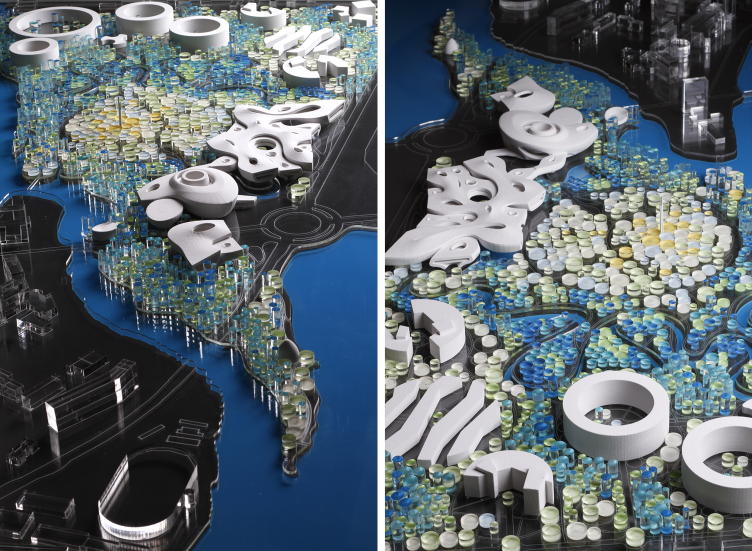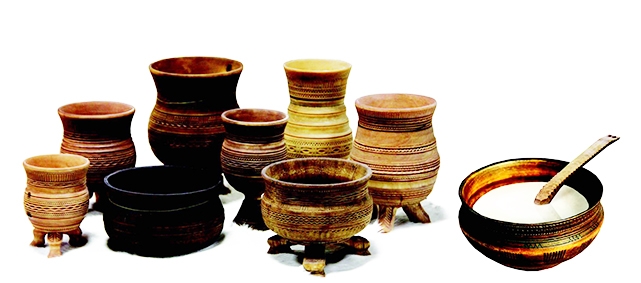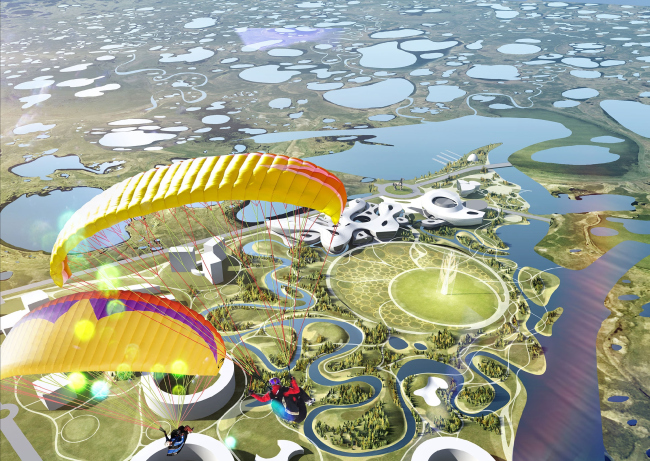
 |
Headed by Vera Butko and Anton Nadtochiy of "Atrium" Bureau, this consortium was one of the ten teams that took part in the international competition for the best landscape and architecture proposal of "Olonkho Land" in Yakutsk. And although the proposal of "Atrium" did not make the finalist four that the judging panel selected in the late September, we start our story of the Yakutia contest with this particular project where the authors were able not only to feel but also to even multiply the tough and sturdy symbolism of the northern epos, growing it into simple forms and subjecting the ethnic stylization to the flexible plastics and emotional expression.
The complexity and the character of the task that the contestants were faced with can be compared to those of Moscow's "Zaryadye" Park (in that contest, "Atrium" also participated as part of MVRDV consortium that took the third place. The significance of the place is also just as great; however, the Yakut contest got less press coverage than the Moscow one, while the scale of construction in this case is greater. On the 47 hectares of vacant land in the center of Yakutsk, it was necessary to create a landscape and Ethnography Park, squeezing into it a conglomerate of residential and office properties, museums, theaters, innovation Technopark, and a production center. Moreover, the territory of the future park, between the sacred lake of Saisara and the Teploe ("Warm") creek is considered the place where all the Yakut nation come from - meaning, the cradle of the nation. Up to the 1990's the neighboring pleasure ground, located across the road, hosted the main Yakut celebration "Ysakh" (marking the end of a year's cycle). The new complex, living up to its name, must reflect entire depth of Yakut epos “Olonkho” and be resonant to it. Actually, the very idea of its creation has to do to a large extent with the fact that the city of Yakutsk has for a long time been claiming the unofficial status of the capital of the world's north.
The lineup of the team that worked on this concept stands up to the magnitude of the Yakutsk city government. For the first time around, "Atrium" stood out as the head of a consortium - uniting a few Russian and foreign designers. The landscaping part of the project was done by the Dutch bureau LAP Landscape & Urban Design, founded by Sander Lap who used to work in West 8; the structures, engineering communications, and the green technologies were handled by Verner Zobek from Stuttgart; the lighting solutions were developed by Austrian designers Lichttechnische Planung. An important participant in this team was a young Yakut architect, laureate of Vladimir Tatlin prize, Gennady Popov. The architects also got assistance from the ethnographer, a specialist in Yakut culture from Tarutsk University Aimar Ventsel. As the authors of the project aptly say, this contest task is a rare case of the situation when the source material, including the kind that is filled with deep meaning, is truly abundant; the architects did not need to go in search of the cultural meaning among the oblique hints of the history of this place, all they had to do was just give them a lot of thought, and try to comprehend them - which the architects did, as we see, with a lot of zeal.
Here one will see the "super-human" landscape of rare beauty and magnificence, the annual temperature drop of more than a hundred degrees centigrade, the world's biggest city standing on permafrost, or rather, a point of growth of this city together with its epos that was meant to be the basis of the project .
The architects at once fell in love with this faraway land the moment that they saw from the bull's eye of the airplane the spotty landscapes of the alaases - the giant thawing clearings around the Taiga's lake that appear when the permafrost starts melting, and the intricate "meanders" of the local rivers that dissect these landscapes. This natural geometry determined that fractional pattern, on the basis of which the authors "grew” their park. They came up with a sophisticated structure that at the same time produces a very "natural" impression and reflects a whole set of the venue's circumstances. The starting point was the necessity of creation the "Field of Celebration": a large round clearing for organizing celebrations with a capacity of be enough for up to 150 000 people during the large-scale celebration, like Ysyakh, is located next to the water's edge. Its boundary is defined by the channel, as winding as the large rivers. Among other things, it serves to drain the land plot, while the earth remaining from its digging will be used to embellish the plastics of the terrain - currently the land site is almost flat.
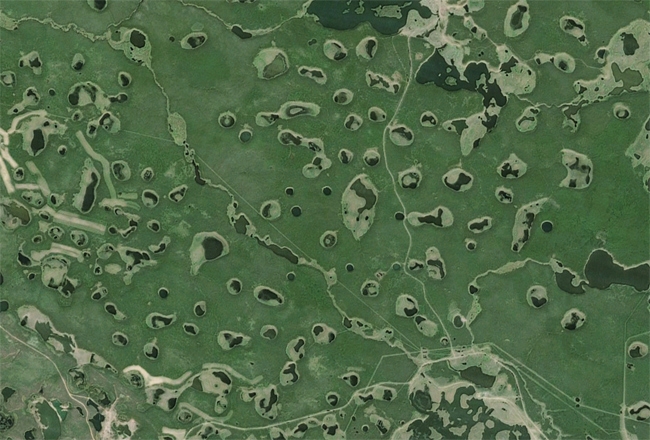
 |
In the middle of this Alaas clearing, the architects placed something which, according to the archetypes of numerous cultures must be in the center of the whole world - the world tree; in the Yakut epos it is called Aal Luuk Mas. However - and this is important - it does not even look very much like a tree. In Atrium's interpretation this is a semi-transparent pillar of the media screen capable of showing anything, and crowned with a sightseeing platform.
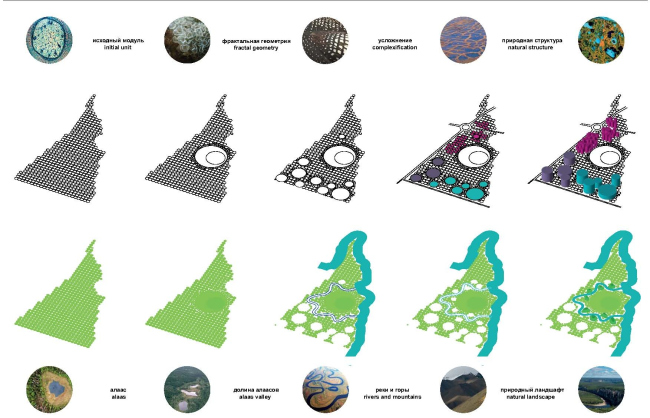
 |

 |
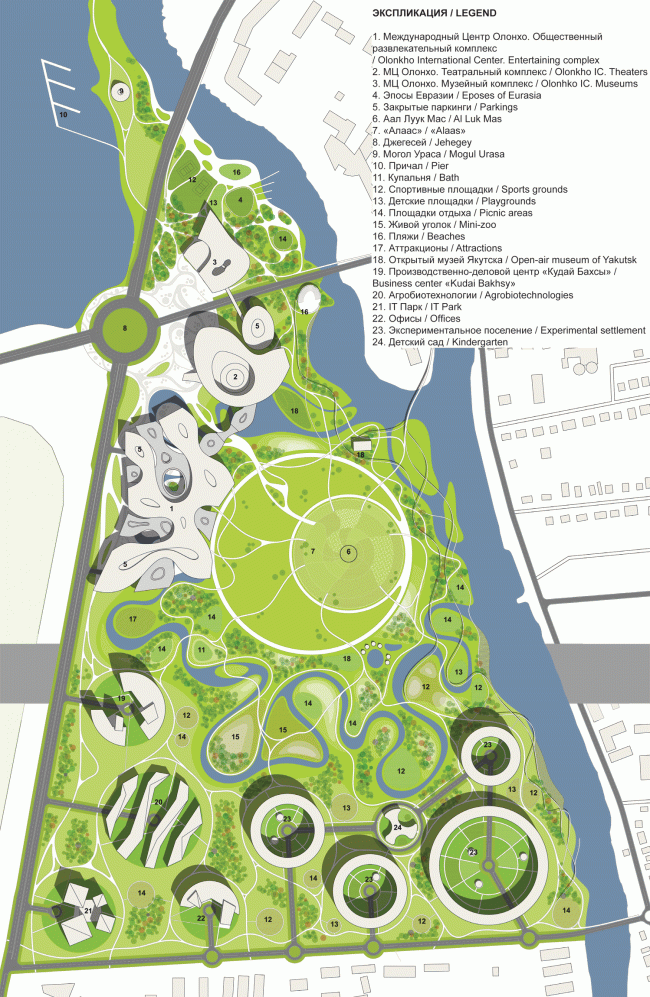
 |
The inevitable figures of the symbolic program connected with the culture and epos, are treated by the architects as the meaningful landmarks of the complex. Accordingly, the town-planning analysis of the land plot’s location was carried out. At the joint of the land site and the Saisara Lake, where the street from the other bank of the Teploe Creek comes, the architects created the Grand Square, marking it with the necessary (again, in accordance with the specifications) sculpture of the legendary Jesegay horse, “the younger brother of the creator of the universe”. “Model of the world mountain Mogol Urasa” that was needed for organizing the rituals, was mover over to the Northern Cape, to the quietest part of the site. The opposite side of the territory is designated for the residential and other functions. Actually, it is between them that the park is created – its organization will provide the necessary smoothness of transition from the space of activity to the space of peace and concentration on the sacred meanings of the cradle of the Yakut people.
Still, the key challenge of this project was the requirement to create a modern architectural expression of the local culture. The Yakut culture did not leave any significant structures of capital character: despite the rigid continental climate, important events take place in the open air. What was required was the materialization of the myths and poetry in the forms vital for the XXI centuries, and the architects find the clue in one Ysyakh rituals. It is called “Kumys Tyusulge” and looks as follows: the traditional cups (named “chorons”) are placed together one next to another on a special mat, and then in one motion of the vessel, the Kumys is poured into them (proverbial nomad light-alcohol drink made from horse milk). After which, the feasting begins that, just like in many other cultures, is considered to be the significant act of unity I the face of the higher powers.
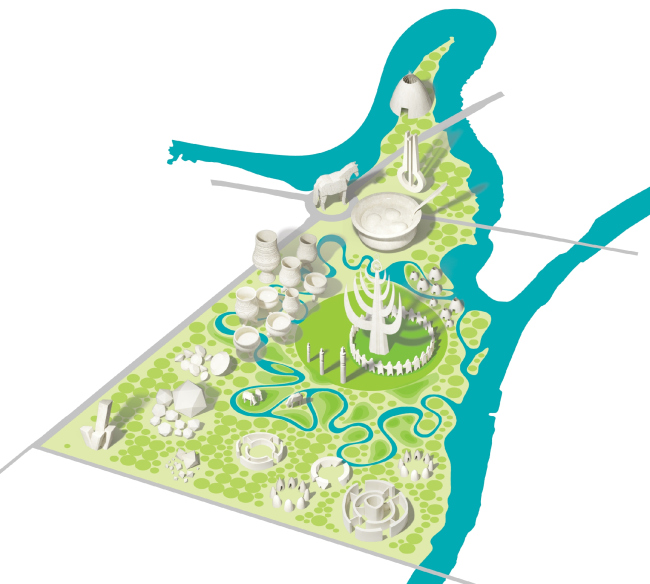
 |
All this abundance of chorons became the prototype of the architectural nucleus of the complex - a group of museums, theaters, and exhibition halls united under the common name of "International Center Olonkho". The thing is that this shape of a cup with a narrow base is the optimal one in terms of melting the earth of the permafrost. All the Yakutsk building are built on supports today. A lot of people will recollect the Mammoth Museum designed by Thomas Leeser for this city, and it also rested on the supports, although of a different kind.
This is how the "choron" buildings appeared, place close together and partly merging into one another in such a way that they start looking like some curious biological form. They are permeated by a glowing network of lobbies - as we we caught the cups at the moment when milk was being pouted down into them in a liberal flow, the way when you pour into all the vessels at once. On the inside, the buildings are decorated with a large ornament that enhances their resemblance to the traditional vessel; the pattern is really large, into one of these triangles, for example, one can easily inscribe a museum window. Above, the "zenith" windows are installed where necessary - they let in the daylight and they are resonant with the image of the "choron": the "cup" windows open up, however symbolically, like real vessels. On the visual level, the "cup" theme is articulated thanks to the cutaway along the line of the road in whose direction the pure surfaces the stained-glass windows are turned. The same way as the Lena River had once made a way for itself, laid bare the structure of the plateau and gave this land one of the most beautiful sights of Yakutia - the Lena columns.
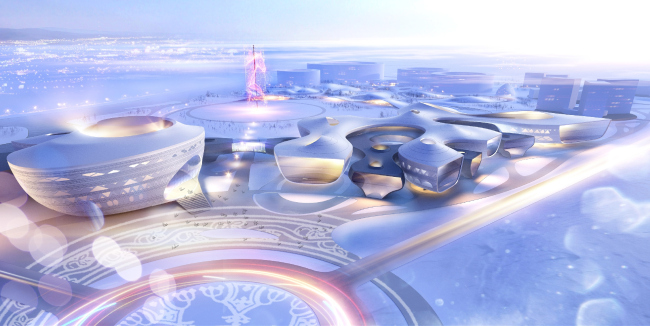
 |
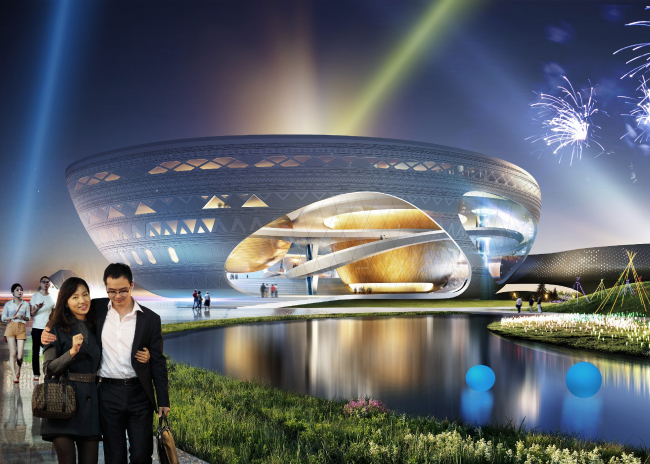
 |
Among all the buildings of the complex, particular attention was to be paid, in accordance with the contest specifications, to the building of the theater. The Yakut minister of culture and spiritual development is accidentally also the main director of "Olonkho" theater whose troupe is world-famous for its unique approach to interpreting the traditional folk culture in the forms of modern theatrical art. This theater - Yakut Academic Drama theater named after P.Oinunsky (the steady winner of the "Golden Mask" prize, as well as the Opera and Ballet theater were to be united under one roof. The end result was called Kytyya by the locals - this word means a special plate for whipping butter from Kumys milk: this is yet another ritual action that means "undulating of the world ocean", the breath of life, akin to the Act of Creation. The resulting butter is likened to "kut" - meaning "soul". In the architectural expression, the "butter balls" turned into golden volumes of the three theater halls. If we are to remember that the ancient Greeks considered the catharsis that springs out from the drama play part of the renewal of one's soul, then the whole idea makes perfect sense. Incidentally, one of the ideologists of the contest "Olonkho Land" Elena Fedorova analyzed in her articles the Yakut epos in comparison with the Ancient Greek.
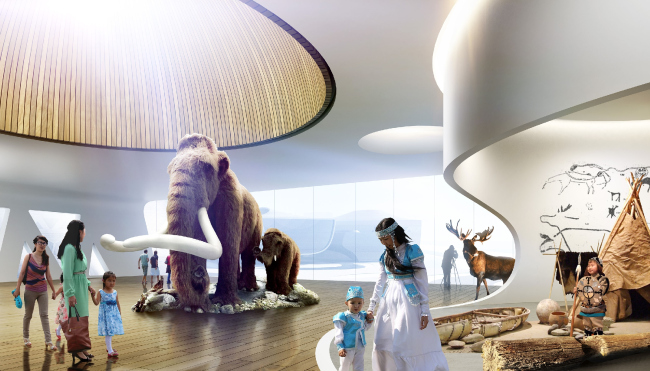
 |
Yet another two "chorons" house the museums, institutes, and a planetarium, while the community and trade center occupied a multitude of "milk-splashed" shallow cups. Each function is accompanied by the provision of a warm parking garage inside its "legs". The architects came up with a plan if gradual, several-stage construction of these buildings: first, for better balance, they want to build three "choron" modules, then all the other parts can be added on step by step, one module after another, simultaneously solving the issues of their functional meaning depending on the current market situation.

 |
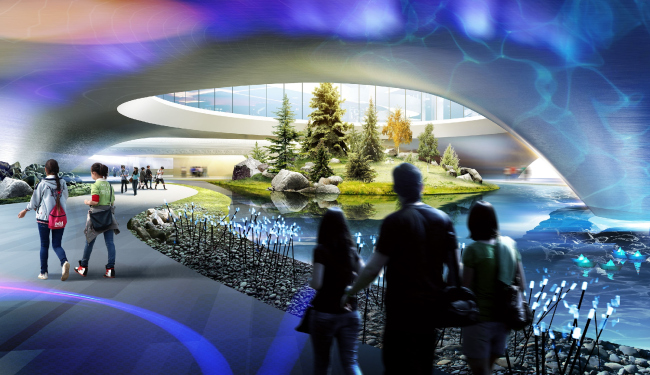
 |
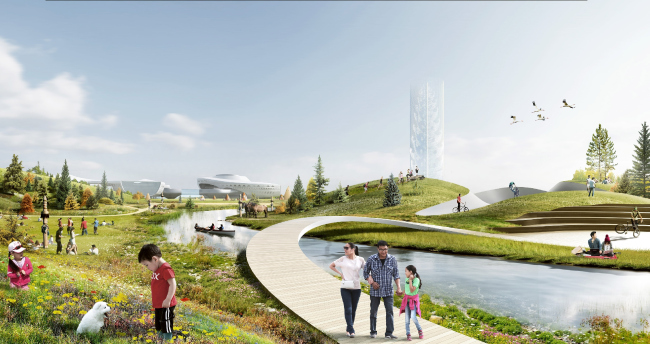
 |
The more pragmatic, residential-and-scientific part of the complex is located in the southern part of the park. According to the architects' plan, the projects of the residential buildings and the innovation techno park will be developed via special dedicated contests (one of these actually took place early this year, and, incidentally, one of the short list nominees is the project by Gennady Popov, the architect that already worked with "Atrium" consortium. In this particular area, the architects cast but a brief outline of what will be here: the residential houses are likened to the circular Siberian "arch-towns", while the techno park is likened to diamonds, the faceted underground precious stones, whose abundance is also inscribed into a circle.

 |
The tough climatic conditions of Yakutsk urged "Atrium" to create a temporary pavilion mean to support the work of the park's infrastructure during the cold months (December-February). The construction named "Myagkaya Zima" ("Soft Winter") will maintain a temperature of -7°С, which will let people ice-skate in comfort when it's below 30 Celsius outside. This was a part of the concept of culturally programming the complex that was also a part of the specifications. A whole calendar with a yearly cycle of festivals, educational and cultural events has been created. For this calendar, three key themes were selected that supported the meaning of the complex on the software level: tradition, ecology, and innovation. The infrastructure was also thought out to the last detail: the transport layout with lots of bicycle trails and other alternative means of transportation, various pavilions... Special mention should be given to the organization of the park landscape landscape with a multitude of various activity zones: the channel delineates the sacred space of the celebrations, the hills are formed from the earth that was excavated at digging the channel and the basement pits. The project carefully describes the green part: the authors chose predominantly local, permafrost-proof types of plants and created a landscape that looks "beautiful most of the year".
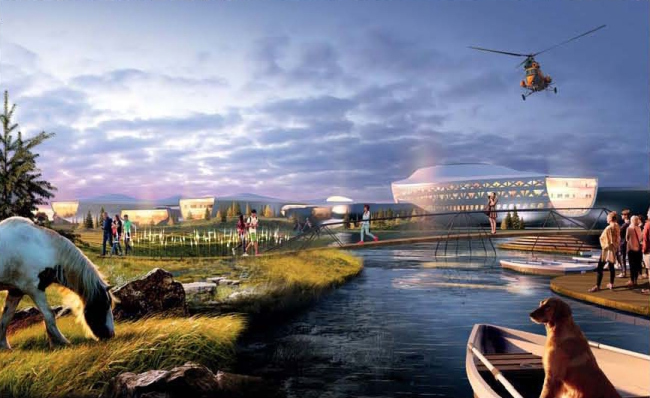
 |
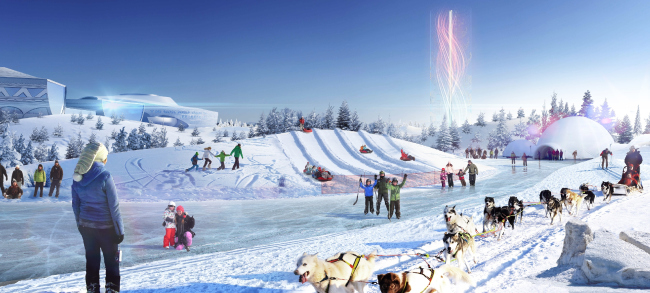
 |

 |
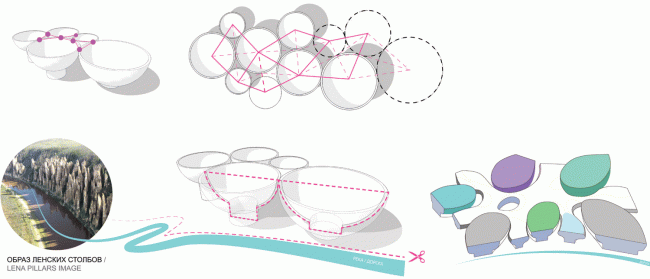
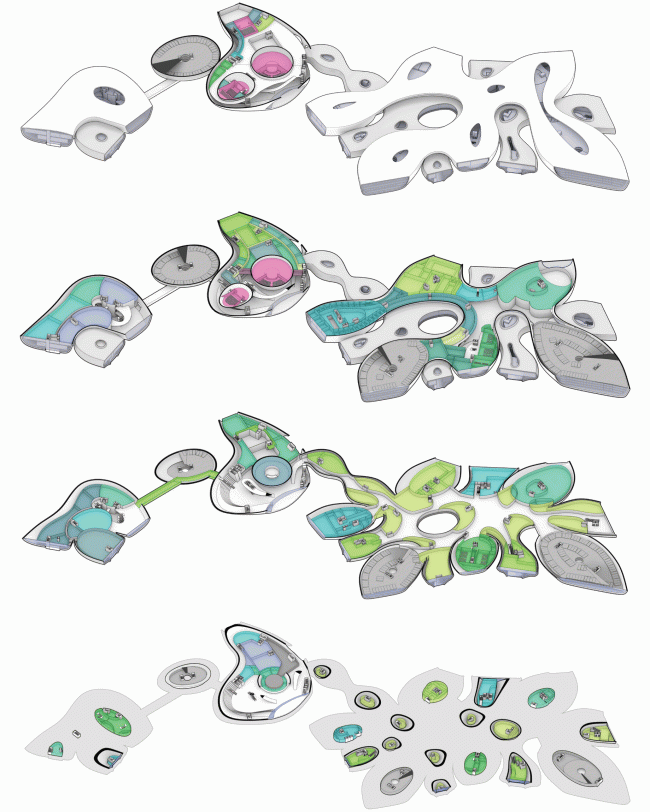
 |
In a word, a sophisticated, multiparty project, saturated with epic symbolism, that miraculously transforms before our eyes into futuristic images and technology-friendly solutions, including lots of "green" ones such as the use of "thermal activation of massive constructions", thermic isolation, the use of gray water and other things that let the architects in code cases achieve the properties of a "passive" house. Besides, the architects claim that all the "daring" and seemingly futuristic solutions are quite technology-friendly and dependable because they are based on, yes, innovative and groundbreaking but still reliable methods and technologies. This is the reaction to the main task of the contest that required creating a strictly Yakut but still up-to-date architectural image that could be interesting to the whole world.
The architects worked on this project for half a year, and in their conversation they use just as surely and just as frequently the terms of the traditional Yakut mythology, as if, during their work, they were able to master a new language - which is partly true. Interesting is how quickly and simply the images of the traditional culture grow into the futuristic plastics blending with today's shape-forming somewhere at the level of the deep-meaning line of the pattern. And it is at this point that you actually recollect that the archaic things have one common thread running through them: the attraction to cyphering and coding, turning the shape into a sign filled with a multitude of meanings. A world where a zigzag and two dots on a concave side of a vessel mean the whole universe with its top and bottom, beginning and end, with all of its mysterious laws and functions. Looking at the concept of the park "Olonkho Land" prepared by Atrium, one might think that the architects actually started to decode these mythical meanings that bear the entire world inside of them, and translate them into the understandable language of the new age but again coded them back, subjected to the logic of the artistic practice of the current "now".
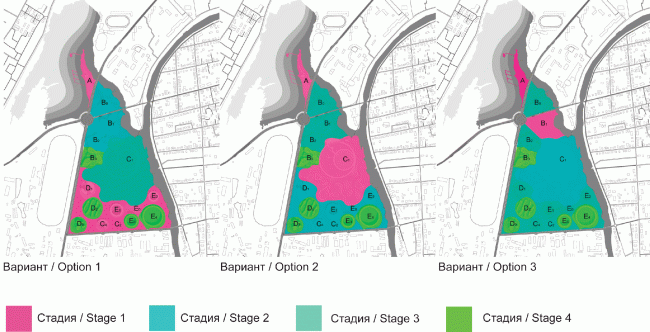
 |
The project of the complex "Olonkho Land" in Yakutia © "Atrium"
The project of the complex "Olonkho Land" in Yakutia © "Atrium"








